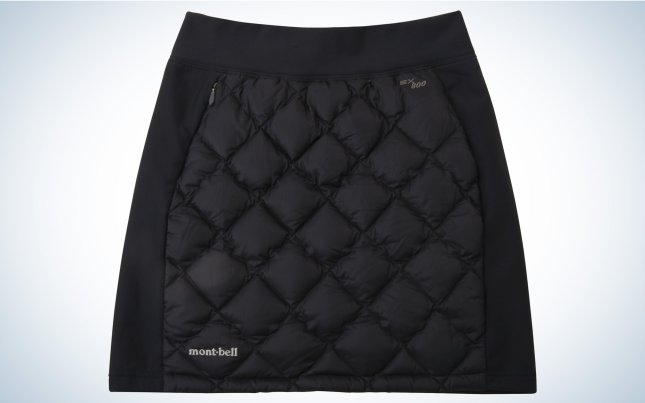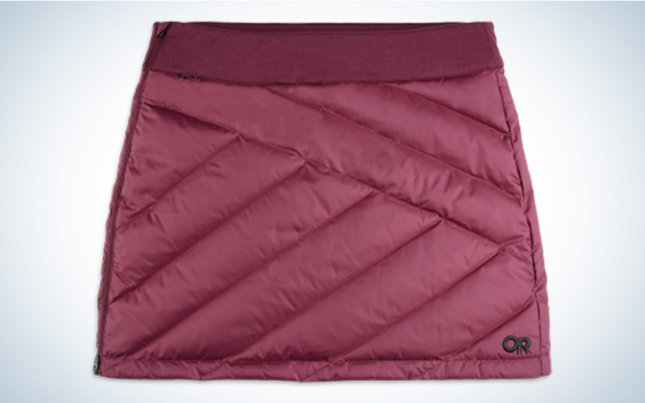We may earn revenue from the products available on this page and participate in affiliate programs. Learn More ›
Introducing the piece of gear you never knew you needed: the insulated skirt. Essentially a puffy for your waist, it’s not just for lounging by the fire. With shorter hems and an ergonomic fit you can wear your puffy skirt on a run, snowshoe, or hike. They’re also warm enough for sitting in a blind and stylish enough to après. I took these insulated skirts into varying conditions to test how they perform in active settings and spoiler: It might be your new favorite winter wear.
- Best for Running: Montbell Superior Down Trail Skirt
- Best for Hiking: Outdoor Research Coldsnap Down Skirt
- Best for Skiing: Rab Women’s Cirrus Insulated Skirt
Testing the Best Insulated Skirts
I wore these insulated skirts for a variety of activities to determine how warm, mobile, and convenient they were in winter conditions. After running, hiking, and skiing in puffy skirts from three major brands, I can confidently say that the best insulated skirt will become a fall, winter, and spring staple for conditions ranging from chilly to frigid. It’s a versatile layer that allows you to dress for active days while staying toasty or bundle up for blinds, breaks, or sporting events.
Insulated Skirts Reviews and Recommendations
What’s the point of an insulated skirt? Skirts are open at the bottom, but the hot air will rise and stay trapped in sewn through insulation instead of falling out. This gives you a personal bubble of warmth surrounding a major artery for extra chilly days. It covers your femoral artery which provides blood flow for the lower half of your body. The relatively small amount of insulation will keep you toastier than expected by increasing warm blood flow.
Your butt and thighs are typically fattier than the rest of your body, allowing them to chill more easily. If you’ve ever braved temps below your sleeping bag’s rating you might have noticed your butt getting cold first. An insulated skirt adds an extra layer where you need it most.
A puffy skirt is like wearing a built in butt pad, making it ideal for breaks and sitting on cold surfaces. If you start hiking early in the morning while temps are low you can wear a puffy skirt that allows for plenty of mobility to start off the day and easily shed this compact and stretchy layer without taking off your shoes or pack later in the day. I tested popular models with differing features to highlight the advantages of insulated skirts on trail, on a mountain, or around town.
Best for Running: Montbell Superior Down Trail Skirt
Best for Running
Montbell Superior Down Trail Skirt
Key Features
- Fill Power: 800 fp down
- Fill Weight: 0.9 ounces
- Weight: 4.2 ounces
- Material: 20-denier Ballistic Airlight nylon ripstop (water repellent finish) with CLIMAPLUS stretchy side-panels
- Length: 17.1 inches (front) 17.7 inches (back)
- Included Stuff Sack: The website says yes, but I did not receive one.
Pros
- Lightweight
- Shorter hem for increased mobility
- One zipper pocket
Cons
- Low fill weight
The Montbell Light Down Pants won the award for the best ultralight puffer pants, but if you’re looking to shed weight, the insulated skirt is 4.2 ounces compared to 7.1 for the pants. The Montbell Trail Skirt has a respectable 800 fill power down at a relatively low fill weight, but in my opinion, a little goes a long way. This skirt heats up fast, especially when you’re in motion. It’s perfect for over leggings on a cold run and as a backpacking layer for camp and early morning starts.


Because it is thin and lightweight with the shortest hem on this list, the Trail skirt is ideal for running. You have a free range of motion and plenty of warmth for high activity on freezing days. If you’re not interested in taking the winter off, keep running comfortably in this sleek option.
Ballistic Airlight nylon ripstop is designed to be ultralight as well as durable. This abrasion resistant shell can stand up to some bushwhacking and wasn’t phased when tested in a skinny sandstone slot canyon. There are two side panels that stretch for freedom of movement. These CLIMAPLUS sections retain warmth and flexibility for running and hiking. There’s also a zippered pocket for a few essentials. There is no closure mechanism on this skirt, just a flat and comfortable elastic band that easily stretches to slide down.
Best for Hiking: Outdoor Research Coldsnap Down Skirt
Best for Hiking
Outdoor Research Coldsnap Down Skirt
Key Features
- Fill Power: 700 fp down
- Fill WEight: 3.8 ounces
- Weight: 6.74 ounces
- Material: 53 percent recycled Pertex Quantum Eco Polyester 30D nylon
- Length: 16 inches
- Included Stuff Sack: No
Pros
- Puffier than the Montbell
- One zipper pocket
- Full length two-way side zipper
Cons
- Heavy
This extra puffy down-filled skirt is perfect for frigid day hikes and long sits in the blind. It’s wind and water resistant for wintry hikes and the black version is quiet enough for hunting. It’ll provide the necessary insulation and warmth for breaks and ridgelines and the flexibility to hike, snowshoe, or even cross country ski.
Outdoor Research’s Coldsnap Down Skirt is versatile and performs in harsh weather. It also has a two-way zipper on the side for easy on and off. It can also be zipped up from the bottom for even more mobility. While it has less fill power than the Montbell, it is noticeably puffier and features responsibly sourced down instead of the typically heavier and colder synthetic of the Cirrus. However, the Coldsnap is still the heaviest on this list. But at only 6.7 ounces, it’s still lightweight enough for active adventures.
Best for Skiing: Rab Women’s Cirrus Insulated Skirt
Best for Skiing
Rab Women's Cirrus Insulated Skirt
Key Features
- Fill Power: 100 percent recycled PrimaLoft Silver Insulation Luxe
- Weight: 6.6 ounces
- Material: Recycled 30D nylon Pertex Quantum (DWR finish) and elastane stretch side panels
- Length: 18 inches (size 12)
- Included Stuff Sack: Yes
Pros
- Recycled materials
- Full length two-way front zipper
- Two zipper pockets
Cons
- Synthetic insulation
The first difference to note between the Rab and the other two skirts on this list is that the Rab is synthetic filled. More weather resistant and 100 percent recycled, the synthetic fill has some major pros though it’s typically not as warm. However, in this case, the Rab has visibly more insulation resulting in a puffier puffy skirt. This is my go-to layer when I’m headed to the resort to ski. I throw on my thermals, puffy jacket, and puffy skirt and keep my shell layers stowed until I’m ready to wrap myself in gore-tex.
I stay plenty warm de-icing my windshield, grabbing a caffeine fix, and waiting for lifts to open in this system. The Rab Cirrus Skirt also features a full length zipper that allows for venting and easy on and off. There’s an additional button clasp and Velcro at the top to keep it secure when in motion. The longer hemline doesn’t make it as running friendly as the Montbell, but it’s great for hikes, around town, and bundling up in cold temps.
Things to Consider Before Buying an Insulated Skirt
Intended Activity
There’s a surprising amount of variety in insulated skirts. Some wrap around you or are almost full-length. These are great options if you’re sitting in a blind, by the fire, or watching a sporting event, but not ideal for a free range of movement. I focused on shorter skirts to allow for a lot of activity. Some are also heavier and less compressible than others, which will make it harder to stow and carry into the backcountry.
Insulation
The insulation in a puffy skirt will contribute to how compressible it is but the warmth it provides is more important. While synthetic insulation has a lot of advantages like staying warm even when wet, down is king when it comes to packability and the warmth-to-weight ratio. The warmer and heavier skirts on this list are the Coldsnap and the Cirrus, but Montbell’s light but quality insulation will still keep you outside longer (and happier) than without one of the best insulated skirts.
Closure Mechanism
Whether you can unzip or pull off the skirt, easy take off is a necessity for insulated skirts because they work so well. They should be designed to be simply shed once you’re completely warm or ready to change into ski clothes. On a cold hike, slow stalk, or freezing run you might keep on your skirt for the duration of your activity, but a full-length zipper or stretchy waistband is key for a versatile layer.
Read Next: The Best Hiking Leggings of 2023
FAQs
A puffy skirt covers a major artery in your groin to circulate warm blood throughout your lower body. It also protects the typically fattier (and therefore more susceptible to cold) parts of your body from freezing temperatures. An insulated skirt keeps you warmer than expected in a convenient and shedable layer.
You can cross country ski in one of the best insulated skirts as it is similar to running, hiking, or snowshoeing. However downhill or ski touring would be ill-advised as you should be wearing snow pants for optimal waterproofing and free range of motion. A puffy skirt is great for pre- or post-skiing though and ideal for après.
The best insulated skirt is one that allows you to move freely, insulates against the cold, and is easily put on and removed.
Final Thoughts
A puffy skirt might sound silly in theory, but in practice they work to insulate where you need it most in a highly convenient layer. If you’ve ever sweated out fleece lined leggings on trail, an insulated skirt is for you. It allows you to dress comfortably for activity without suffering through freezing early hours, sedentary sections, or in-between moving moments. There are plenty of options out there but the Montbell Superior Down Trail Skirt, Outdoor Research Coldsnap Down Skirt, and Rab Women’s Cirrus Insulated Skirt versions encompass two ways to wear the best insulated skirts.
- Best for Running: Montbell Superior Down Trail Skirt
- Best for Hiking: Outdoor Research Coldsnap Down Skirt
- Best for Skiing: Rab Women’s Cirrus Insulated Skirt






